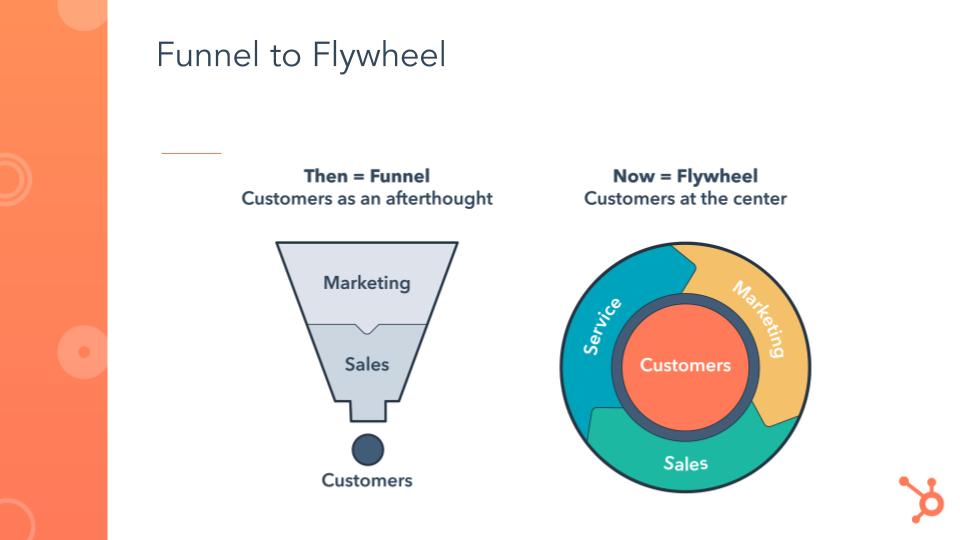Going From Funnel to Flywheel and What It Means for B2B Marketers
Written by
 Attract. Engage. Delight. What if the well-known mantra of inbound marketing was reinvented to a customer-centric model that unites all stages of the methodology and focuses your Marketing, Sales, and Service teams around one common goal?
Attract. Engage. Delight. What if the well-known mantra of inbound marketing was reinvented to a customer-centric model that unites all stages of the methodology and focuses your Marketing, Sales, and Service teams around one common goal?
That’s the question HubSpot posed in light of increasing evidence that the traditional funnel model is failing industrial marketers and salespeople. Why? The funnel suggests customers are an afterthought in the process when, in fact, they are a driving force — 73% of business growth is derived from word-of-mouth and customer referrals.
That’s a massive amount of influence, and it shines a light on the funnel’s fatal flaw: the loss of momentum at the very time it’s needed most — when serving a new customer.
Enter the HubSpot Flywheel. It’s a new way to structure the marketing, sales and service processes to leverage the word-of-mouth and other third-party recommendations that 81% of B2B buyers trust when making purchase decisions, and keep your business spinning.
Why the Flywheel?

Source: HubSpot, The Flywheel
Comparing the two side by side, the power of transitioning from the funnel to flywheel thinking is readily apparent. Shifting customers from the product of a process to the dynamic center of a continuous business growth cycle also changes B2B marketer focus and causes you to make different decisions. With a flywheel approach, you can identify and remedy points of momentum-killing friction in Marketing, Sales and Service — which results in delighted customers that feed company growth.
3 Factors That Dictate Flywheel Success
The Flywheel is an efficient business strategy that works well provided B2B marketers remain cognizant of three make-or-break factors, as explained by HubSpot’s VP of Marketing Jon Dick:
1. How fast the flywheel spins
Apply more force in the areas where it has the biggest impact and flywheel speed increases — giving you the all-important momentum in not only attraction and acquisition of customers as in the funnel but also in delighting customers to help them be successful, which encourages them to spread the word about you.
2. How much friction the flywheel encounters
Force creates speed but it can also create friction if all of the flywheel parts aren’t aligned. Sales, Marketing, and/or Service teams out of step? Friction! Friction creates inefficiencies and slows the process. Getting to the bottom of the processes and other reasons friction exists — silos, handoffs, organizational structures, etc. — shines a light on areas of improvement that impact conversion rates, customer delight, and customer churn. Fix those impediments and your flywheel speed picks up exponentially.
3. The weight and size of the flywheel
Customers drive both of these flywheel dimensions. The more delighted customers that are on board, the “heavier” the flywheel. When those customers (and those they refer) expand the products and services they use from you, the “larger” the flywheel. Combine the two and business growth happens — and continues.
Related: How to Maximize Your Inbound Marketing Funnel for Sales
How do I Get Started?
How do you make the transition to the inbound flywheel? What does it mean for the future of B2B marketing and sales? Watch this video series from Inbound Strategist, Frank Isca as he unpacks how to use the flywheel to identify opportunities to grow your business better:
Ready to learn more?
Watch our on-demand webinar, Moving from Sales Funnel to Inbound Flywheel, and see what it takes to remove friction and add force to marketing, sales, and customer service.
Ready to put it into practice?
Download our complete Flywheel Overview & Workbook to assess your current flywheel and prioritize the biggest opportunities.
Subscribe To Our Blog
Information. Insights. Ideas. Get notified every time a new Weidert Group blog article is published – subscribe now!
You May Also Like...

Artificial Intelligence
Revenue-Driving B2B Content Marketing Strategy with Andy Crestodina

Artificial Intelligence
AI Agents Are Here—How Smart Businesses Are Using Them Now

Inbound Marketing
Podcasting Playbook: What We Learned After 100 Days of Running a B2B Podcast
Accelerate Your Growth with
Weidert Group
If you’re ready to explore a partnership, request a personalized consultation with our team.


